Rare Chromosomal Uniformity in Black Flies of the Simulium striatum Species Group (Diptera: Simuliidae)
Simple Summary
Abstract
1. Introduction
2. Materials and Methods
3. Results
3.1. Chromosomal Generalities
3.2. Species Group Characterization
3.3. Interspecific Differences
3.4. Intraspecific Variation
4. Discussion
Author Contributions
Funding
Data Availability Statement
Acknowledgments
Conflicts of Interest
References
- Coyne, J.A.; Orr, H.A. Speciation; Sinauer Associates: Sunderland, MA, USA, 2004; 545p. [Google Scholar]
- White, M.J.D. Modes of Speciation; W. H. Freeman and Co.: San Francisco, CA, USA, 1978; 455p. [Google Scholar]
- King, M. Species Evolution: The Role of Chromosome Change; Cambridge University Press: New York, NY, USA, 1993; 336p. [Google Scholar]
- Rothfels, K.H. Cytotaxonomy of black flies (Simuliidae). Annu. Rev. Entomol. 1979, 24, 507–539. [Google Scholar] [CrossRef]
- Rothfels, K.H. Speciation in black flies. Genome 1989, 32, 500–509. [Google Scholar] [CrossRef]
- Thapa, S.; Procunier, W.; Henry, W.; Chhetri, S. Heterochromatin and sibling species of Simulium praelargum s. l. (Diptera: Simuliidae). Genome 2014, 57, 223–232. [Google Scholar] [CrossRef] [PubMed]
- Adler, P.H.; Yadamsuren, O.; Procunier, W.S. Chromosomal translocations in black flies (Diptera: Simuliidae)–facilitators of adaptive radiation? PLoS ONE 2016, 11, e0158272. [Google Scholar] [CrossRef]
- Thaijarern, J.; Pramual, P.; Adler, P.H. Limited differentiation among black flies in the Simulium multistriatum species group (Diptera: Simuliidae) in Thailand: Cryptic species, homosequential species, and homosequential cryptic species. Zool. J. Linn. Soc. 2018, 184, 1024–1054. [Google Scholar] [CrossRef]
- Shields, G.F.; Procunier, W.S. Sympatric speciation in the Simulium arcticum s. l. complex (Diptera: Simuliidae): The Rothfels model updated. Ecol. Evol. 2019, 9, 8265–8278. [Google Scholar] [CrossRef]
- Rothfels, K.H. Black flies: Siblings, sex, and species grouping. J. Hered. 1956, 47, 113–121. [Google Scholar] [CrossRef]
- Adler, P.H.; Cheke, R.A.; Post, R.J. Evolution, epidemiology, and population genetics of black flies (Diptera: Simuliidae). Infect. Gen. Evol. 2010, 10, 846–865. [Google Scholar] [CrossRef]
- Hebert, P.D.N.; Cywinska, A.; Ball, S.L.; de Waard, J.R. Biological identifications through DNA barcodes. Proc. R. Soc. Lond. B 2003, 270, 313–321. [Google Scholar] [CrossRef]
- Adler, P.H.; Crosskey, R.W. Cytotaxonomy of the Simuliidae (Diptera): A systematic and bibliographic conspectus. Zootaxa 2015, 3975, 1–139. [Google Scholar] [CrossRef]
- Pangjanda, S.; Pramual, P. Tests of conspecificity for closely related black flies (Diptera: Simuliidae) species of the Simulium striatum group in Thailand. Zootaxa 2017, 4231, 421–430. [Google Scholar] [CrossRef]
- Moulton, J.K. Reexamination of Simulium (Psilopelmia) Enderlein (Diptera: Simuliidae) of America north of Mexico. Proc. Entomol. Soc. Wash. 1998, 100, 50–71. [Google Scholar]
- Takaoka, H. The Black Flies of Subtropical and Tropical Asia: Taxonomy and Biology; Springer Nature: Singapore, 2024; 765p. [Google Scholar]
- Adler, P.H. World Blackflies (Diptera: Simuliidae): A Comprehensive Revision of the Taxonomic and Geographical Inventory. 2025. Available online: http://biomia.sites.clemson.edu/pdfs/blackflyinventory.pdf (accessed on 30 January 2025).
- Srisuka, W.; Aupalee, K.; Takaoka, H.; Otsuka, Y.; Saeung, A. Taxonomy and molecular phylogeny of a new species of black fly (Diptera: Simuliidae) in the Simulium striatum species-group from central Thailand. J. Med. Entomol. 2025, tjaf016. [Google Scholar] [CrossRef] [PubMed]
- Rubtsov, I.A. Blackflies (Simuliidae), 2nd ed.; Fauna of the USSR. Diptera, 6 (6); E. J. Brill: Leiden, The Netherlands, 1990; 1042p. [Google Scholar]
- Rubtsov, I.A.; Yankovsky, A.V. New genera and subgenera of black flies (Diptera, Simuliidae). Entomol. Obozr. 1982, 61, 183–187, In Russian, English translation: Entomol. Rev. 1982, 61, 176–181. [Google Scholar]
- Crosskey, R.W. An annotated checklist of the world black flies (Diptera: Simuliidae). In Black Flies: Ecology, Population Management, and Annotated World List; Kim, K.C., Merritt, R.W., Eds.; Pennsylvania State University: University Park, PE, USA, 1988; pp. 425–520. [Google Scholar]
- Takaoka, H. The black flies of Taiwan (Diptera: Simuliidae). Pacif. Insects 1979, 20, 365–403. [Google Scholar]
- Crosskey, R.W.; Howard, T.M. A New Taxonomic and Geographical Inventory of World Blackflies (Diptera: Simuliidae); Natural History Museum: London, UK, 1997; 144p. [Google Scholar]
- Hew, Y.X.; Ya’cob, Z.; Adler, P.H.; Chen, C.D.; Lau, K.W.; Sofian-Azirun, M.; Muhammad-Rasul, A.H.; Putt, Q.Y.; Izwan-Anas, N.; Hadi, U.K.; et al. DNA barcoding of black flies (Diptera: Simuliidae) in Indonesia. Parasit. Vectors 2023, 16, 248. [Google Scholar] [CrossRef]
- Pramual, P.; Jumpato, W.; Adler, P.H. Fast-evolving nuclear genes as barcoding markers for black flies (Diptera: Simuliidae) in Thailand. Acta Trop. 2023, 246, 106988. [Google Scholar] [CrossRef]
- Putt, Q.Y.; Ya’cob, Z.; Adler, P.H.; Chen, C.D.; Hew, Y.X.; Izwan Anas, N.; Lau, K.W.; Sofian Azirun, M.; Pham, X.D.; Takaoka, H.; et al. From bites to barcodes: Uncovering the hidden diversity of black flies (Diptera: Simuliidae) in Vietnam. Parasit. Vectors 2023, 16, 266. [Google Scholar] [CrossRef]
- Adler, P.H.; Low, V.L.; Tan, T.K.; Takaoka, H.; Otsuka, Y. Genetic relationships of three species of black flies (Diptera: Simuliidae) in Taiwan. Acta Trop. 2024, 259, 107399. [Google Scholar] [CrossRef]
- Pramual, P. Population Genetic Structure of Black Flies (Diptera: Simuliidae) from Thailand Inferred from Mitochondrial DNA Sequences. Ph.D. Thesis, Mahidol University, Bangkok, Thailand, 2006; p. 158. [Google Scholar]
- Aupalee, K.; Saeung, A.; Srisuka, W.; Fukuda, M.; Junkum, A.; Pitasawat, B.; Takaoka, H. Three new species of the Simulium (Simulium) striatum species-group (Diptera: Simuliidae) from Thailand, with their phylogenetic relationships. Acta Trop. 2020, 211, 105625. [Google Scholar] [CrossRef]
- Takaoka, H.; Srisuka, W.; Low, V.L.; Saeung, A. A new species of the Simulium (Simulium) striatum species group (Diptera: Simuliidae) from Thailand, and its differentiation from two related species based on a fast-evolving nuclear gene. J. Med. Entomol. 2018, 55, 561–568. [Google Scholar] [CrossRef] [PubMed]
- Aupalee, K.; Srisuka, W.; Saeung, A.; Takaoka, H. A new species of the Simulium (Simulium) striatum species-group (Diptera: Simuliidae) from Thailand and phylogenetic relationship with its Thai members. Acta Trop. 2022, 230, 106387. [Google Scholar] [CrossRef] [PubMed]
- Srisuka, W.; Takaoka, H.; Aupalee, K.; Saeung, A. Discovery of a new black fly species in the Simulium (Simulium) striatum species-group (Diptera: Simuliidae) from northeastern Thailand and its phylogenetic relationships with seven Thai related species. Acta Trop. 2023, 238, 106790. [Google Scholar] [CrossRef]
- Adler, P.H.; Kúdelová, T.; Kúdela, M.; Seitz, G.; Ignjatović-Ćupina, A. Cryptic biodiversity and the origins of pest status revealed in the macrogenome of Simulium colombaschense (Diptera: Simuliidae), history’s most destructive black fly. PLoS ONE 2016, 11, e0147673. [Google Scholar] [CrossRef] [PubMed]
- Bedo, D.G. C banding in polytene chromosomes of Simulium ornatipes and S. melatum (Diptera: Simuliidae). Chromosoma 1975, 51, 291–300. [Google Scholar] [CrossRef]
- Takaoka, H. Morphotaxonomic revision of species-groups of Simulium (Simulium) (Diptera: Simuliidae) in the Oriental Region. Zootaxa 2017, 4353, 425–446. [Google Scholar] [CrossRef]
- Bedo, D.G. Cytogenetics and evolution of Simulium ornatipes Skuse (Diptera: Simuliidae). I. Sibling speciation. Chromosoma 1977, 64, 37–65. [Google Scholar] [CrossRef]
- Kuvangkadilok, C.; Phayuhasena, S.; Boonkemtong, C. Larval polytene chromosomes of five species of blackflies (Diptera: Simuliidae) from Doi Inthanon National Park, Northern Thailand. Cytologia 1999, 64, 197–207. [Google Scholar] [CrossRef][Green Version]
- Tangkawanit, U.; Kuvangkadilok, C.; Baimai, V.; Adler, P.H. Cytosystematics of the Simulium tuberosum group (Diptera: Simuliidae) in Thailand. Zool. J. Linn. Soc. 2009, 155, 289–315. [Google Scholar] [CrossRef]
- Pramual, P.; Thaijarern, J.; Sofian-Azirun, M.; Ya’cob, Z.; Hadi, H.K.; Takaoka, H. Cytogenetic and molecular evidence of additional cryptic diversity in high elevation black fly Simulium feuerborni (Diptera: Simuliidae) populations in Southeast Asia. J. Med. Entomol. 2015, 52, 829–836. [Google Scholar] [CrossRef]
- Takaoka, H.; Srisuka, W.; Maleewong, W.; Saeung, A. New records of 13 species of black flies (Diptera: Simuliidae) from Myanmar. Acta Trop. 2018, 178, 281–289. [Google Scholar] [CrossRef]
- Low, V.L.; Adler, P.H.; Sofian-Azirun, M.; Srisuka, W.; Saeung, A.; Huang, Y.-T.; Hadi, U.K.; Pham, X.D.; Takaoka, H. Tests of conspecificity for allopatric vectors: Simulium nodosum and Simulium shirakii (Diptera: Simuliidae) in Asia. Parasit. Vectors 2015, 8, 297. [Google Scholar] [CrossRef] [PubMed]
- Takaoka, H.; Davies, D.M. The black flies (Diptera: Simuliidae) of Java, Indonesia. Bishop Mus. Bull. Entomol. 1996, 6, 1–81. [Google Scholar]
- Zhang, Y.; Malmqvist, B. Phenotypic plasticity in a suspension-feeding insect, Simulium lundstromi (Diptera: Simuliidae), in response to current velocity. Oikos 1997, 78, 503–510. [Google Scholar] [CrossRef]
- Lucas, P.; Hunter, F.F. Phenotypic plasticity in the labral fan of simuliid larvae (Diptera): Effect of seston load on primary-ray number. Can. J. Zool. 1999, 77, 1843–1849. [Google Scholar] [CrossRef]
- Davies, D.M.; Syme, P.D. Three new Ontario black flies of the genus Prosimulium (Diptera: Simuliidae). Part II. Ecological observations and experiments. Can. Entomol. 1958, 90, 744–759. [Google Scholar] [CrossRef]
- Konurbaev, E.O. Variability of some of the quantitative characters of simuliid larvae (Diptera, Simuliidae) in the mountains of Soviet Central Asia. Entomol. Rev. 1973, 52, 590–595. [Google Scholar]
- Fukuda, M.; Takaoka, H.; Uni, S.; Bain, O. Infective larvae of five Onchocerca species from experimentally infected Simulium species in an area of zoonotic onchocerciasis in Japan. Parasite 2008, 15, 111–119. [Google Scholar] [CrossRef]
- Adler, P.H.; Reeves, W.K.; McCreadie, J.W. Black flies (Diptera: Simuliidae) in the Galapagos Islands: Native or adventive? PLoS ONE 2024, 19, e0311808. [Google Scholar] [CrossRef]
- Henderson, C.A.P. Homosequential species 2a and 2b within the Prosimulium onychodactylum complex (Diptera): Temporal heterogeneity, linkage disequilibrium, and Wahlund effect. Can. J. Zool. 1986, 64, 859–866. [Google Scholar] [CrossRef]
- Adler, P.H.; Inci, A.; Yildirim, A.; Duzlu, O.; McCreadie, J.W.; Kúdela, M.; Khazeni, A.; Brúderová, T.; Seitz, G.; Takaoka, H.; et al. Are black flies of the subgenus Wilhelmia (Diptera: Simuliidae) multiple species or a single geographical generalist? Insights from the macrogenome. Biol. J. Linn. Soc. 2015, 114, 163–183. [Google Scholar] [CrossRef]

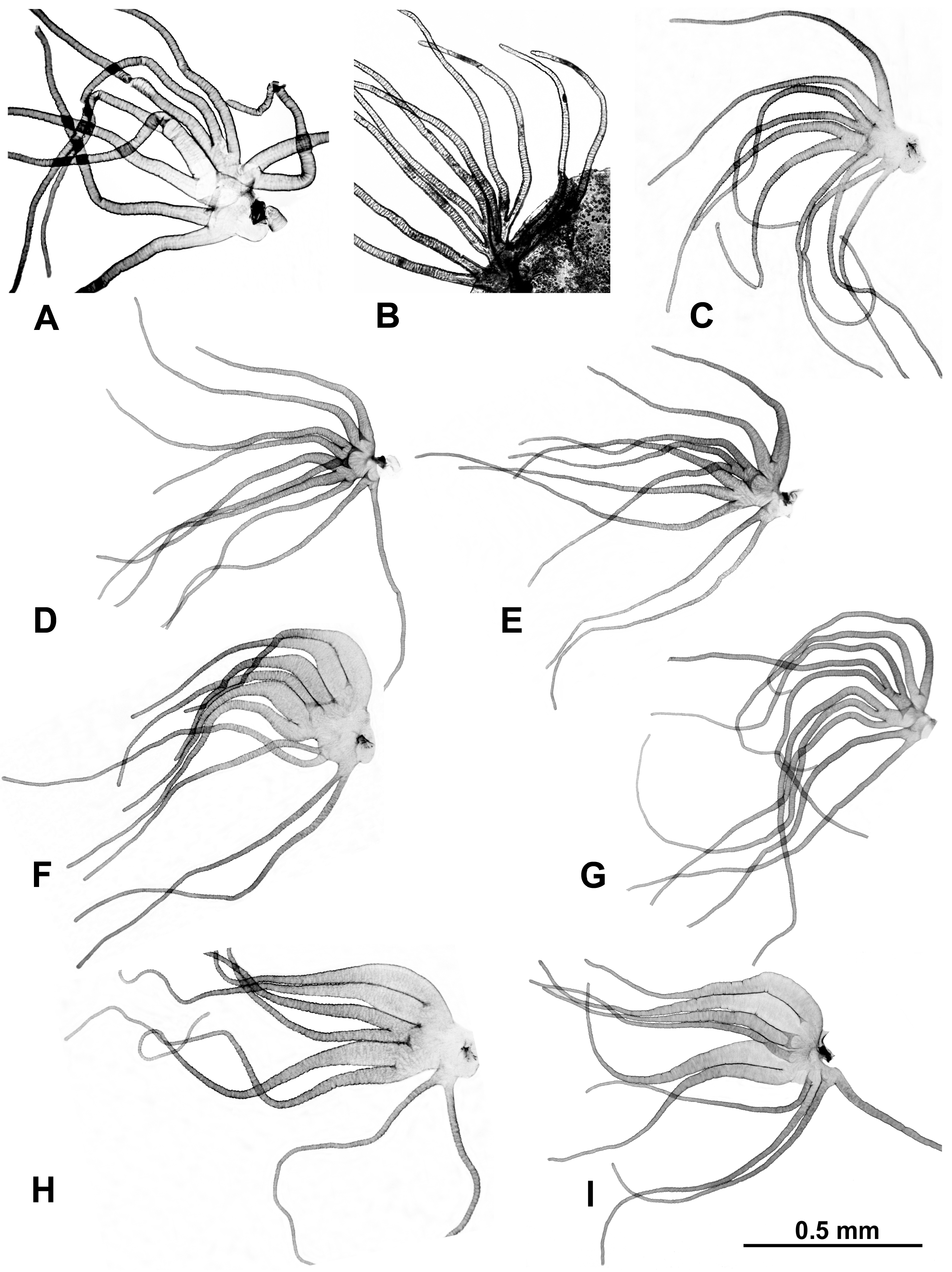
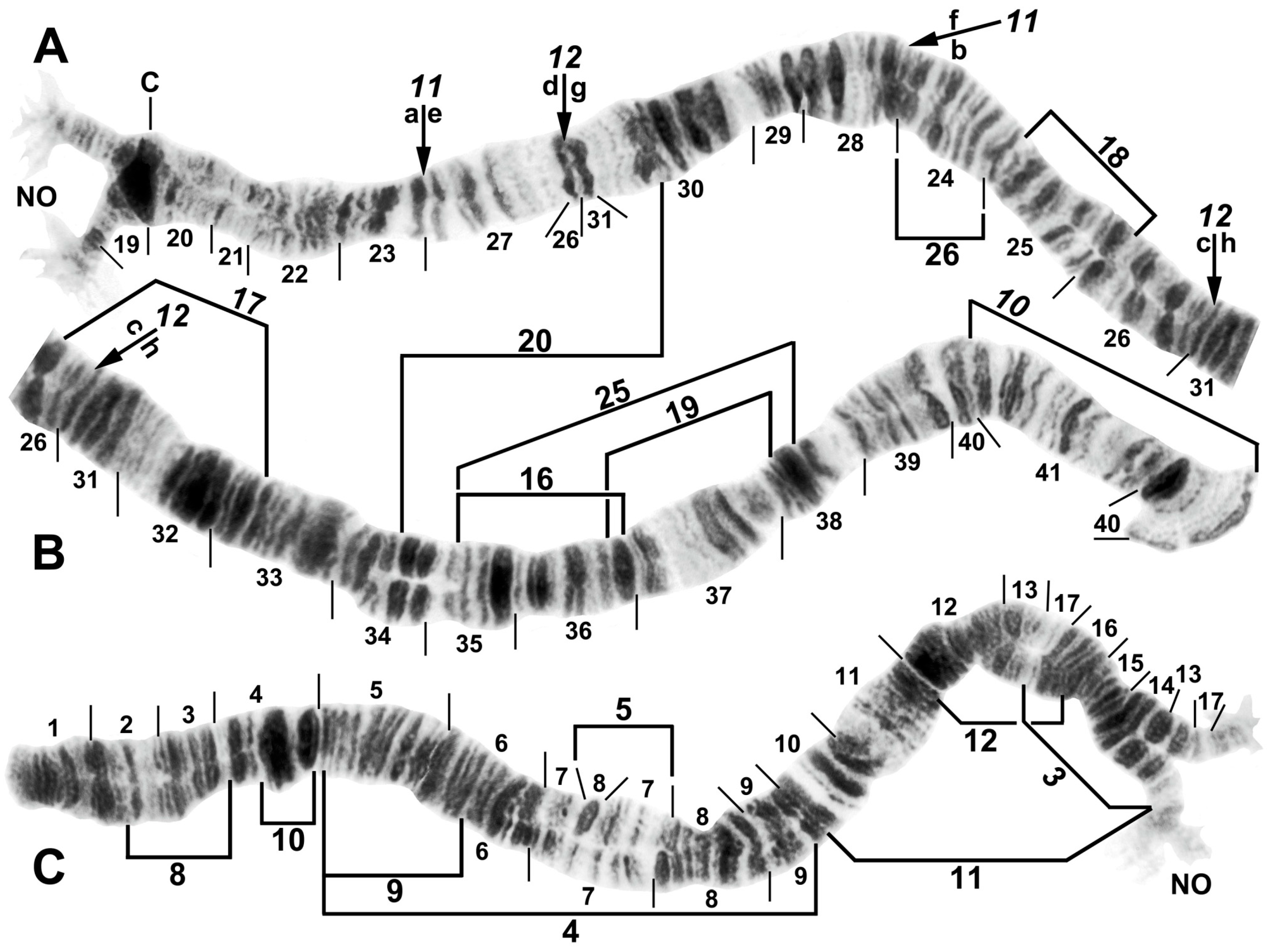


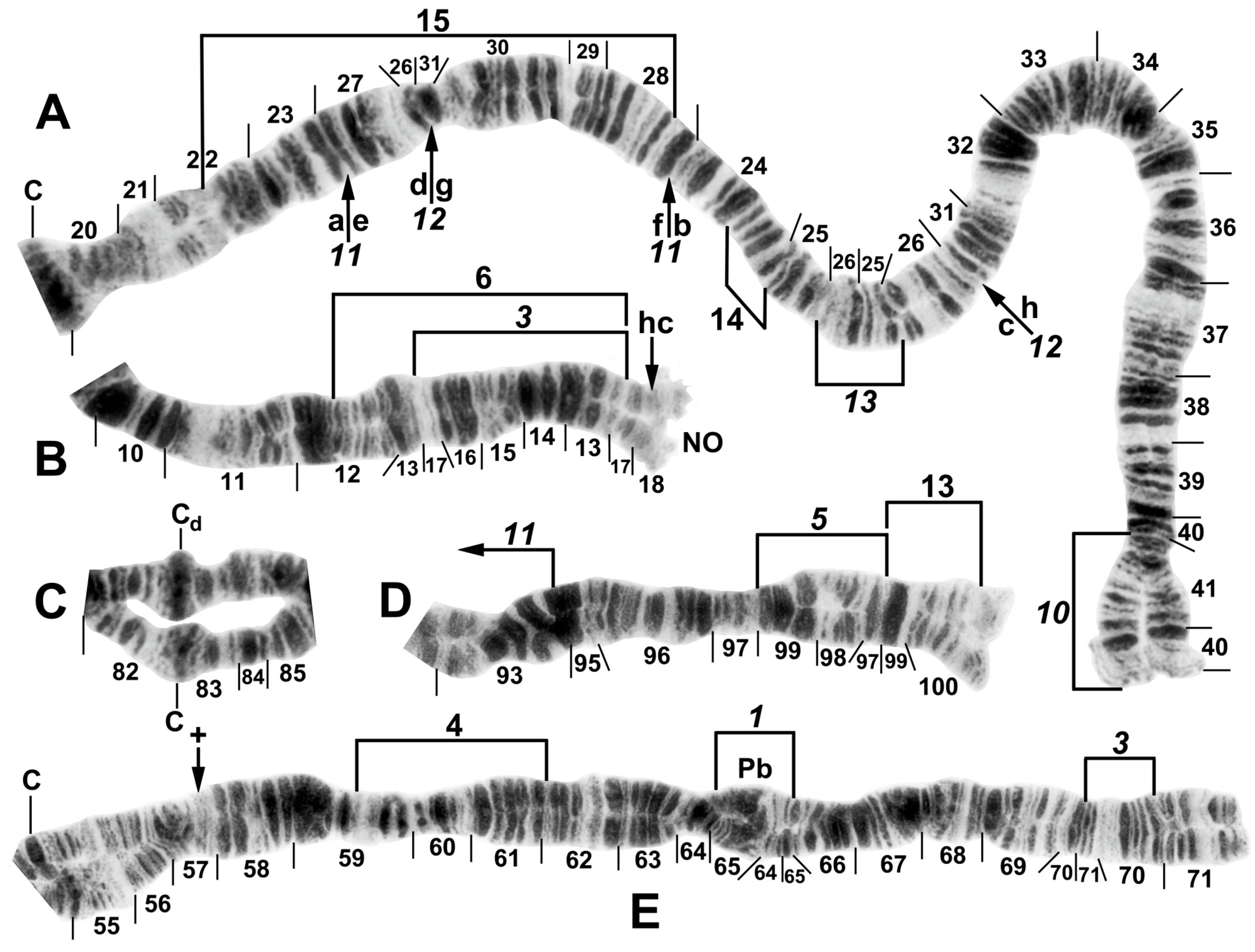
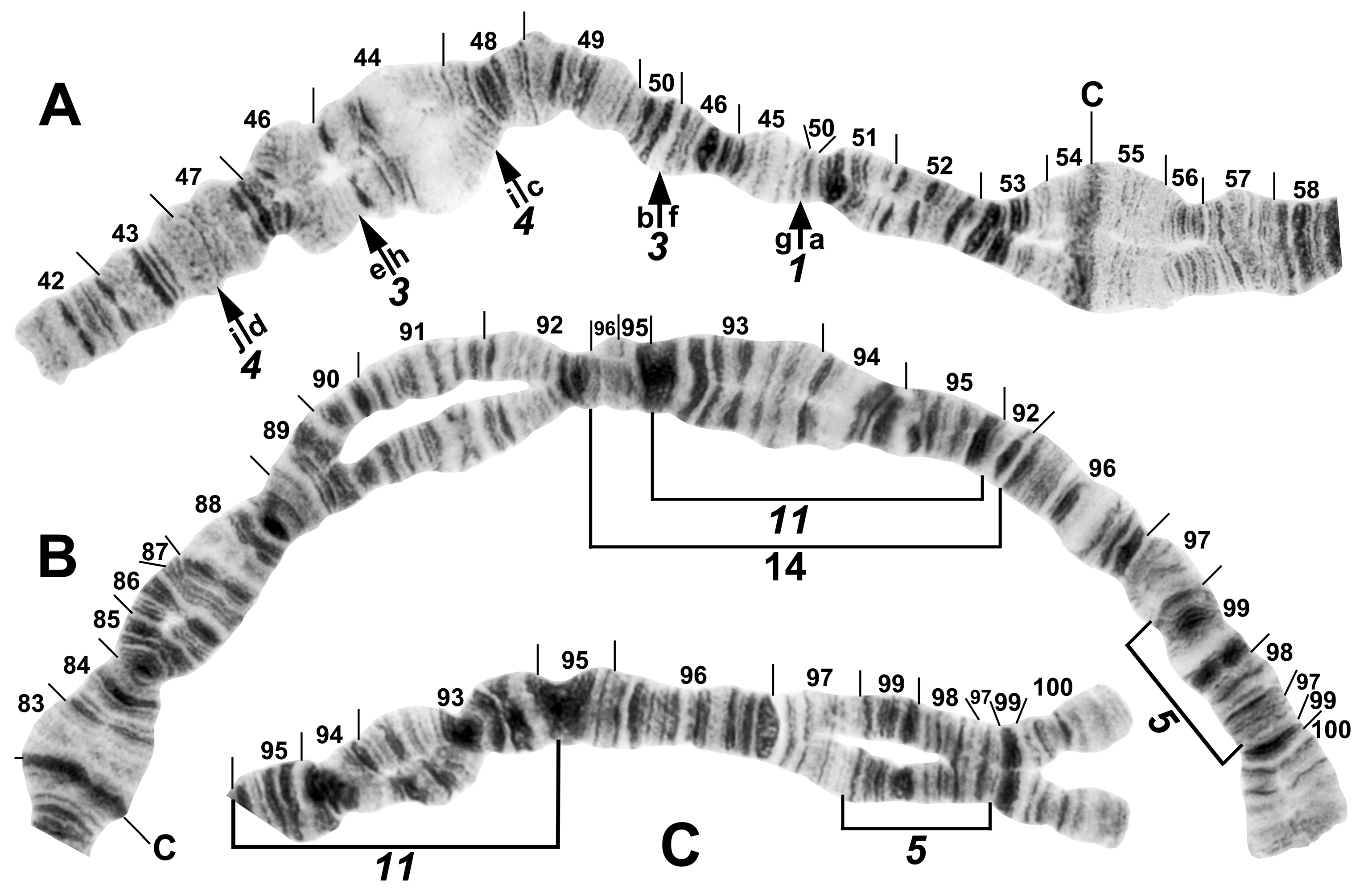

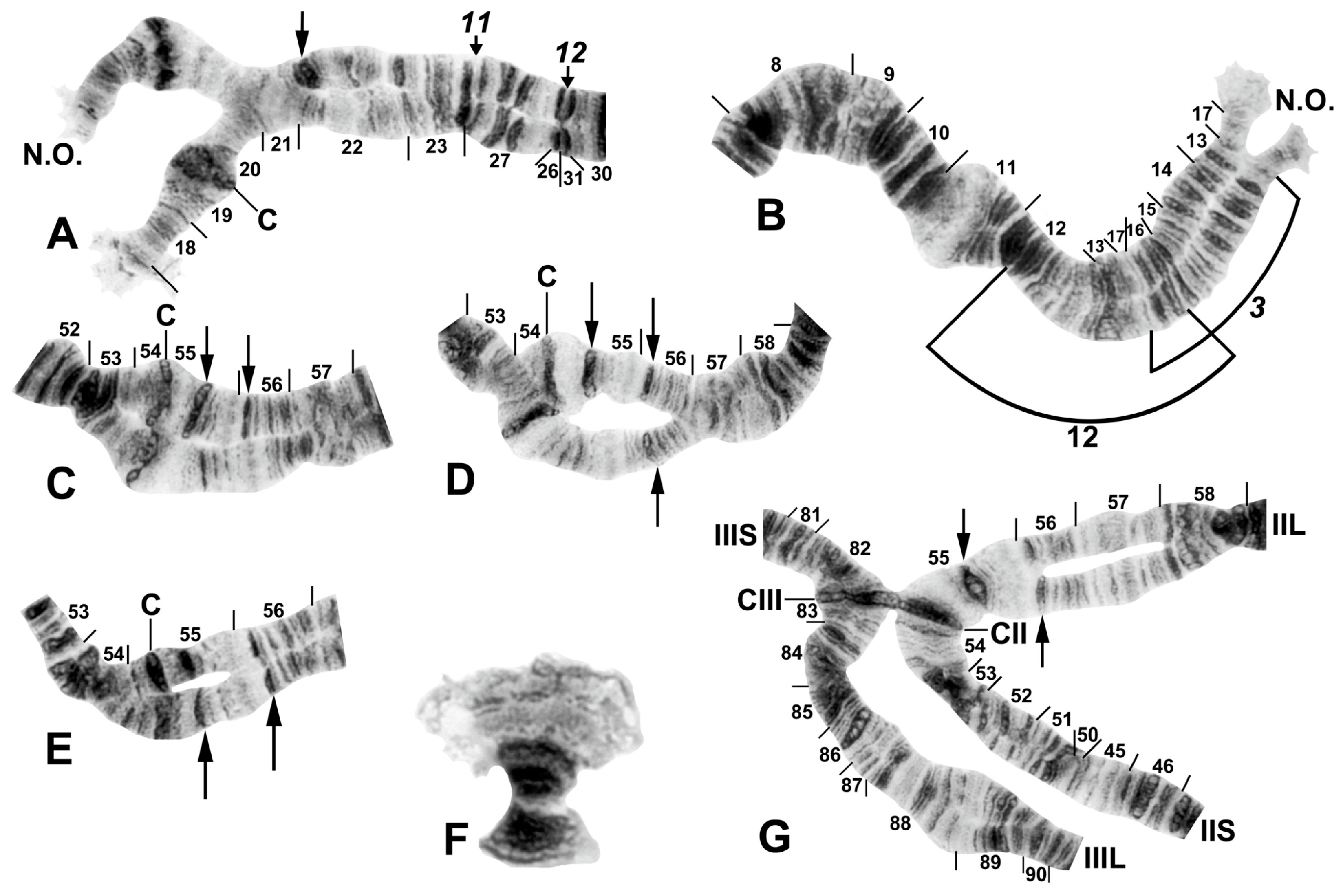
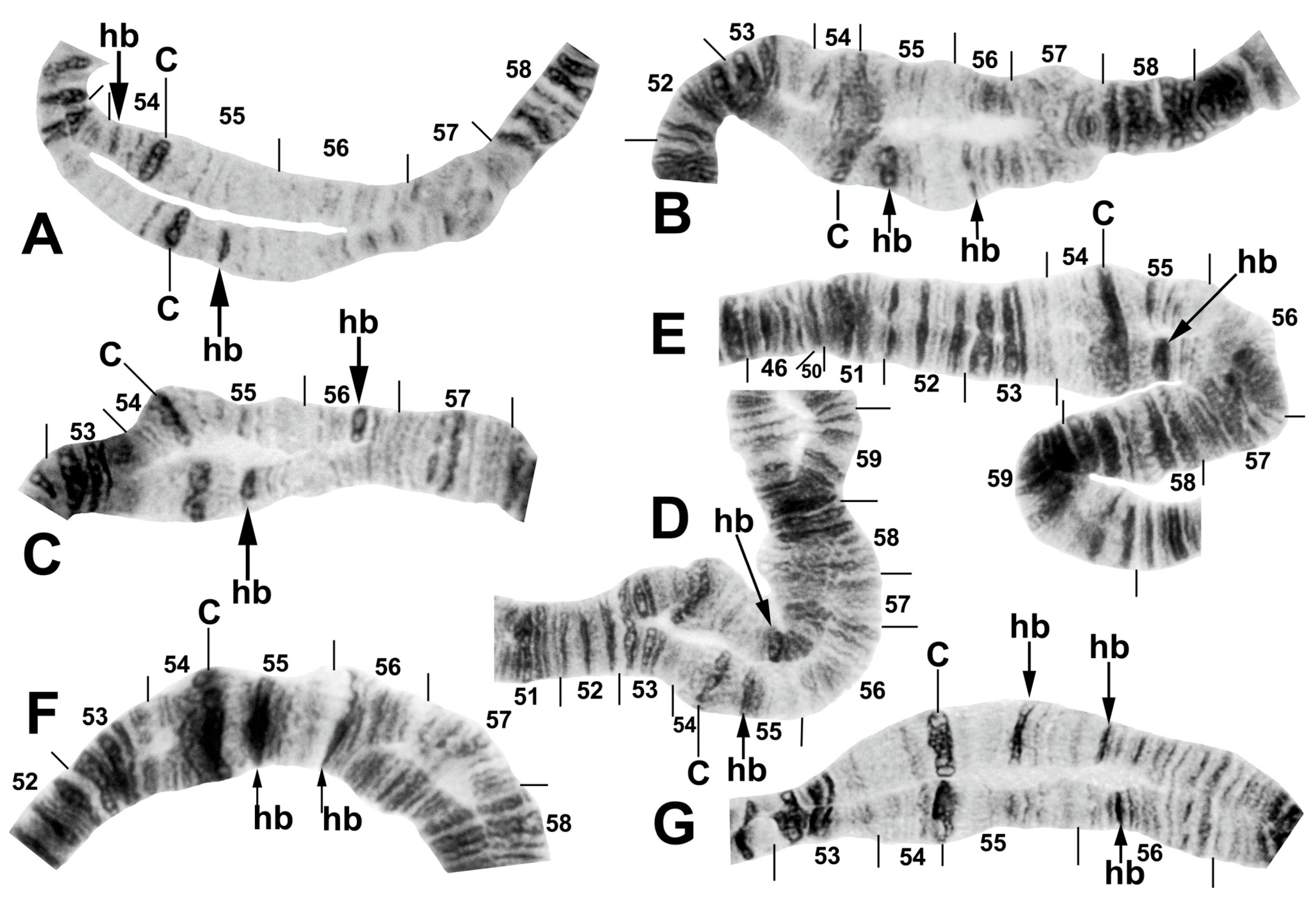
| Site | Location | Longitude Latitude | Elevation (Masl) | Collection Date | Species (n) |
|---|---|---|---|---|---|
| 1 | India, Uttarakhand, Nainital District, Cataliakot River (2.5–3.5 m wide), 900 m above mouth | 29°28′25″ N 79°09′39″ E | 456 | 2 May 2018 | sp. A (33) |
| 2 | India, Uttarakhand, Chamoli District, Pindar River (15–20 m wide), 1 km above Karan-prayg | 30°15′05″ N 79°13′24″ E | 785 | 6 May 2018 | sp. B (11) |
| 3 | Indonesia, Java, Cugur Cilember | 06°39′39″ S 106°56′46″ E | 884 | 25 July 2018 | argyrocinctum (39) |
| 4 | Laos, Xiangkhouang Province, Muang Khoun | 19°13′41″ N 103°21′57″ E | 990 | 8 February 2025 | wangkwaiense (19) |
| 5 | Laos, Xiangkhouang Province, Muang Kham | 19°38′16″ N 103°28′26″ E | 750 | 9 February 2025 | sp. (75), tadtonense (1) |
| 6 1 | Taiwan, Pingtung County, Manjhou, Jioupeng | 22°06′41″ N 120°52′28″ E | 50 | 3 February 2008 | pingtungense (23) |
| 7 1 | Taiwan, Pingtung County, Manjhou, Lide | 22°01′02″ N 120°50′25″ E | 50 | 3 February 2008 | pingtungense (21) |
| 8 2 | Taiwan, Nantou Province, Yuchi Township | 23°52′ N 120°56′ E | 670 | 1 March 2006 | quinquestriatum (6) |
| – | Thailand, 35 sites (Table 2) | (Table 2) | (Table 2) | (Table 2) | striatum group (479) |
| Site | Location | Longitude Latitude | Elevation (masl) | Collection Date | Larvae Analyzed (n) |
|---|---|---|---|---|---|
| 135 | Amnat Chareon Province, Huai Nang Koi waterfall, Phathum Ratchawongsa | 15°53′32″ N 104°54′20″ E | 160 | 23 February 2008 | 3 |
| 208 | Kanchanaburi Province, Tham Than Lod, Si Sawat | 14°40′02″ N 99°19′09″ E | 276 | 30 September 2008 | 7 |
| 223 | Chiang Mai Province, Mae Ya waterfall, Chomthong | 18°26′23″ N 98°35′53″ E | 587 | 21 November 2008 | 9 |
| 246 1 | Ubon Ratchathani Province, Huai Phang | 15°23′28″ N 105°27′16″ E | 189 | 1 November 2009 | 14 |
| 255 | Ubon Ratchathani Province, Kang Lam Duan waterfall, Nam Khun | 14°26′05″ N 105°06′22″ E | 179 | 2 November 2009 | 14 |
| 267 | Loei Province, Pla Ba waterfall, Phuruea | 17°23′19″ N 101°22′11″ E | 649 | 24 November 2009 | 7 |
| 268 | Loei Province, Song Khon waterfall, Phuruea | 17°21′08″ N 101°24′14″ E | 743 | 26 November 2009 | 16 |
| 275 2 | Loei Province, Thansawan waterfall, Na Haeo | 17°29′27″ N 101°03′34″ E | 506 | 27 November 2009 | 10 |
| 284 | Uttaradit Province, Huai Cham Phang | 17°47′00″ N 100°06′56″ E | 130 | 5 December 2009 | 11 |
| 285 | Uttaradit Province, Ban Mae Kam | 18°08′01″ N 100°15′20″ E | 236 | 5 December 2009 | 12 |
| 292 | Nan Province, Ban Rong Ngae, Pua | 19°10′31″ N 100°55′49″ E | 257 | 6 December 2009 | 19 |
| 297 2 | Chiang Mai Province, Mae Klang waterfall, Chomthong | 19°00′59″ N 99°18′11″ E | 615 | 6 December 2009 | 25 |
| 304 | Phitsanulok Province, Chat Trakan waterfall | 17°07′56″ N 100°40′52″ E | 194 | 8 December 2009 | 3 |
| 322 | Kamphaeng Phet Province, Klong Wang Chao waterfall, | 16°30′16″ N 99°09′36″ E | 236 | 19 February 2010 | 31 |
| 323 3,4 | Kamphaeng Phet Province, Klong Wang Chao | 16°30′15″ N 99°10′03″ E | 204 | 19 February 2010 | 27 |
| 327 | Kamphaeng Phet Province, Klong Khlung, Klong Lan | 16°03′43″ N 99°18′53″ E | 118 | 20 February 2010 | 27 |
| 329 | Kanchanaburi Province, Ban Huai Khayeng | 14°35′06″ N 98°35′29″ E | 237 | 20 February 2010 | 11 |
| 333 | Kanchanaburi Province, Huai U-long | 14°32′45″ N 98°47′13″ E | 172 | 20 February 2010 | 16 |
| 339 | Chanthaburi Province, Khao Soi Dao waterfall | 13°19′18″ N 102°11′38″ E | 316 | 3 March 2010 | 10 |
| 349 2 | Sisaket Province, Huai Chan waterfall, Khun Han | 14°31′48″ N 104°21′32″ E | 116 | 15 October 2010 | 10 |
| 351 | Ubon Ratchathani Province, Sirindhorn | 15°12′56″ N 105°27′46″ E | 114 | 16 October 2010 | 11 |
| 356 | Nakhon Phanom Province, Tad Kham waterfall, Ban Phaeng | 17°58′08″ N 104°09′34″ E | 122 | 17 October 2010 | 10 |
| 360 | Bueng Kan Province, Jed Si waterfall (1), Se ka | 18°15′51″ N 103°54′21″ E | 169 | 18 October 2010 | 9 |
| 361 2,4 | Bueng Kan Province, Jed Si waterfall (2), Se ka | 18°15′51″ N 103°54′21″ E | 169 | 18 October 2010 | 12 |
| 369 2,5 | Chiang Mai Province, Mae Klang waterfall, Chomthong | 18°29′39″ N 98°40′07″ E | 304 | 16 January 2015 | 11 |
| 372 2 | Chiang Mai Province, Huai Mae Um long | 18°09′22″ N 98°13′06″ E | 852 | 16 January 2015 | 10 |
| 374 | Mae Hong Son Province, Mae Sariang | 18°08′33″ N 97°58′35″ E | 203 | 16 January 2015 | 12 |
| 375 | Mae Hong Son Province, Mae La Noi | 18°22′41″ N 97°56′32″ E | 270 | 16 January 2015 | 12 |
| 376 | Mae Hong Son Province, Khun Yuam | 18°38′39″ N 97°56′29″ E | 471 | 16 January 2015 | 16 |
| 379 | Mae Hong Son Province, Mueang Mae Hong Son | 19°29′45″ N 98°03′21″ E | 495 | 17 January 2015 | 24 |
| 380 6 | Mae Hong Son Province, Pang Mapha | 19°30′37″ N 98°15′46″ E | 610 | 17 January 2015 | 15 |
| 381 | Mae Hong Son Province, Ban Pang Paek, Pang Mapha | 19°26′14″ N 98°15′49″ E | 787 | 17 January 2015 | 12 |
| 387 7 | Chiang Mai Province, Mae Rim | 18°54′02″ N 98°52′55″ E | 508 | 18 January 2015 | 16 |
| 409 2 | Lampang Province, Wang Thong waterfall | 19°16′16″ N 99°39′50″ E | 510 | 18 December 2015 | 8 |
| 440 | Loei Province, Song Khon waterfall, Phuruea | 17°21′14″ N 101°25′20″ E | 721 | 27 May 2017 | 19 |
| Taxon 1 | argyr. | ping. | quin. | tad. | wang. | sp. | sp. A | sp. B | striatum Group |
|---|---|---|---|---|---|---|---|---|---|
| Site | 3 | 6, 7 | 8 | 5 | 4 | 5 | 1 | 2 | 9 |
| Country | Indon. (Java) | Taiw. | Taiw. | Laos | Laos | Laos | India | India | Thailand |
| F:M | 23 2:16 | 26 3:18 | 4:2 | 0:1 | 12:7 | 38:37 4 | 12:20:1 5 | 4:7 | 249:230 6 |
| IS-3 | 1.00 | 1.00 | 1.00 | 1.00 | 1.00 | 1.00 | 1.00 | 1.00 | 0.999 |
| IS-4 | 0.10 | ||||||||
| IS-5 | 0.01 | ||||||||
| IS-6 | 0.02 | ||||||||
| IS-8 | 0.18 | ||||||||
| IS-9 | 0.14 | ||||||||
| IS-10 | 0.001 | ||||||||
| IS-11 | 0.02 | ||||||||
| IS-12 | 0.007 | ||||||||
| IS hc18 7 | 0.01 | ||||||||
| IS 2°NO | 0.08 | ||||||||
| IL-10 | 1.00 | 1.00 | 1.00 | 1.00 | 1.00 | 1.00 | 1.00 | 1.00 | 1.00 |
| IL-11 | 1.00 | 1.00 | 1.00 | 1.00 | 1.00 | 1.00 | 1.00 | 1.00 | 1.00 |
| IL-12 | 1.00 | 1.00 | 1.00 | 1.00 | 1.00 | 1.00 | 1.00 | 1.00 | 1.00 |
| IL-13 | 1.00 | ||||||||
| IL-14 | 0.01 | ||||||||
| IL-15 | 0.01 | ||||||||
| IL-16 | 0.18 | 0.001 | |||||||
| IL-17 | 0.02 | ||||||||
| IL-18 | 0.18 | ||||||||
| IL-19 | 0.09 | ||||||||
| IL-20 | 0.001 | ||||||||
| IL-25 | 0.001 | ||||||||
| IL-26 | 0.001 | ||||||||
| IL hb22 | 0.02 | ||||||||
| CI diffuse | 0.08 | ||||||||
| IIS-1 | 1.00 | 1.00 | 1.00 | 1.00 | 1.00 | 1.00 | 1.00 | 1.00 | 1.00 |
| IIS-3 | 1.00 | 1.00 | 1.00 | 1.00 | 1.00 | 1.00 | 1.00 | 1.00 | 1.00 |
| IIS-4 | 1.00 | 1.00 | 1.00 | 1.00 | 1.00 | 1.00 | 1.00 | 1.00 | 1.00 |
| IIS-5 | 0.001 | ||||||||
| IIS-6 | 0.002 | ||||||||
| IIS-7 | 0.001 | ||||||||
| IIS-8 | 0.002 | ||||||||
| IIS-9 | 0.003 | ||||||||
| IIS-10 | 0.002 | ||||||||
| IIS-11 | 0.001 | ||||||||
| IIS-basal 8 | 0.001 | ||||||||
| IIS hb54 | 0.01 | ||||||||
| IIL-1 | 1.00 | 1.00 | 1.00 | 1.00 | 1.00 | 1.00 | 1.00 | 1.00 | 1.00 |
| IIL-3 | 1.00 | 1.00 | 1.00 | 1.00 | 1.00 | 1.00 | 1.00 | 1.00 | 1.00 |
| IIL-4 | 0.01 | ||||||||
| IIL-5 | 0.001 | ||||||||
| IIL hb55 | 0.57 9 | 0.17 | |||||||
| IIL hb55′ | 0.08 | ||||||||
| IIL hb56 | 0.45 9 | 0.02 | |||||||
| IIL hb56′ | 0.08 | 0.003 | |||||||
| IIL hb57 | 0.01 | ||||||||
| IIL hb60 | 0.08 | ||||||||
| CII diffuse | 0.003 | ||||||||
| IIP-1 | 0.08 | ||||||||
| IIP-2 | 0.002 | ||||||||
| IIIS-1 | 0.007 | ||||||||
| IIIL-5 | 1.00 | 1.00 | 1.00 | 1.00 | 1.00 | 1.00 | 1.00 | 1.00 | 1.00 |
| IIIL-11 | 1.00 | 1.00 | 1.00 | 1.00 | 1.00 | 1.00 | 1.00 | 1.00 | 1.00 |
| IIIL-12 | 0.01 | ||||||||
| IIIL-13 | 0.01 | ||||||||
| IIIL-14 | 1.00 | 0.11 | |||||||
| IIIL-15 | 0.001 | ||||||||
| IIIL-16 | 0.001 | ||||||||
| IIIL-17 | 0.03 | ||||||||
| IIIL-18 | 0.14 | ||||||||
| IIIL-20 | 0.002 | ||||||||
| IIIL-21 | 0.002 | ||||||||
| IIIL-22 | 0.01 | ||||||||
| CIII diffuse | 0.02 | ||||||||
| Bs (%) 10 | 0.0 | 0.0 | 0.0 | 0.0 | 0.0 | 1.3 | 0.0 | 0.0 | 0.004 |
| Species 1 | chiang. | maek. | nakhon. | phra. | poolph. | tadton. | wangk. |
|---|---|---|---|---|---|---|---|
| F:M | 16:13 | 11:9 | 5:6 | 0:1 | 3:11 | 13:12 | 23:28 |
| IS-8 | 0.02 | ||||||
| IL-20 | 0.01 | ||||||
| IIS-9 | 0.02 | ||||||
| IIS-10 | 0.02 | ||||||
| IIS-11 | 0.02 | ||||||
| IIS hb54 | 0.07 | ||||||
| IIL hb55 | 0.24 | 0.15 | 0.14 | 0.50 | 0.29 | 0.30 | |
| IIL hb56 | 0.10 | 0.09 | 0.04 | ||||
| IIL hb56′ | 0.05 | ||||||
| IIIL-14 | 0.74 | ||||||
| IIIL-20 | 0.04 | ||||||
| Bs (%) | 1.96 |
Disclaimer/Publisher’s Note: The statements, opinions and data contained in all publications are solely those of the individual author(s) and contributor(s) and not of MDPI and/or the editor(s). MDPI and/or the editor(s) disclaim responsibility for any injury to people or property resulting from any ideas, methods, instructions or products referred to in the content. |
© 2025 by the authors. Licensee MDPI, Basel, Switzerland. This article is an open access article distributed under the terms and conditions of the Creative Commons Attribution (CC BY) license (https://creativecommons.org/licenses/by/4.0/).
Share and Cite
Adler, P.H.; Vlasov, S.; Huang, Y.-T.; Hadi, U.K.; Inkhavilay, K.; Malavong, B.; Topolenko, V.; Gomontean, B.; Jumpato, W.; Mintara, R.; et al. Rare Chromosomal Uniformity in Black Flies of the Simulium striatum Species Group (Diptera: Simuliidae). Insects 2025, 16, 511. https://doi.org/10.3390/insects16050511
Adler PH, Vlasov S, Huang Y-T, Hadi UK, Inkhavilay K, Malavong B, Topolenko V, Gomontean B, Jumpato W, Mintara R, et al. Rare Chromosomal Uniformity in Black Flies of the Simulium striatum Species Group (Diptera: Simuliidae). Insects. 2025; 16(5):511. https://doi.org/10.3390/insects16050511
Chicago/Turabian StyleAdler, Peter H., Sergey Vlasov, Yao-Te Huang, Upik K. Hadi, Khamla Inkhavilay, Banchai Malavong, Varvara Topolenko, Bhuvadol Gomontean, Waraporn Jumpato, Ronnalit Mintara, and et al. 2025. "Rare Chromosomal Uniformity in Black Flies of the Simulium striatum Species Group (Diptera: Simuliidae)" Insects 16, no. 5: 511. https://doi.org/10.3390/insects16050511
APA StyleAdler, P. H., Vlasov, S., Huang, Y.-T., Hadi, U. K., Inkhavilay, K., Malavong, B., Topolenko, V., Gomontean, B., Jumpato, W., Mintara, R., Namtaku, S., Thanee, I., Wannasingha, W., Wongpakam, K., Jaroenchaiwattanachote, C., & Pramual, P. (2025). Rare Chromosomal Uniformity in Black Flies of the Simulium striatum Species Group (Diptera: Simuliidae). Insects, 16(5), 511. https://doi.org/10.3390/insects16050511







